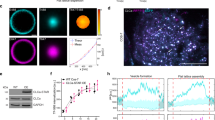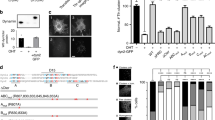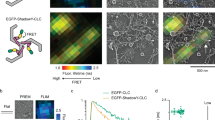Abstract
Dynamin has an important role in clathrin-mediated endocytosis by cutting the neck of nascent vesicles from the cell membrane. Here, using gold nanorods as cargos to image dynamin action during live clathrin-mediated endocytosis, we show that, near the peak of dynamin accumulation, the cargo-containing vesicles always exhibit abrupt, right-handed rotations that finish in a short time (~0.28 s). The large and quick twist, herein named the super twist, is the result of the coordinated dynamin helix action upon GTP hydrolysis. After the super twist, the rotational freedom of the vesicle increases substantially, accompanied by simultaneous or delayed translational movement, indicating that it detaches from the cell membrane. These observations suggest that dynamin-mediated scission involves a large torque generated by the coordinated actions of multiple dynamins in the helix, which is the main driving force for vesicle scission.
This is a preview of subscription content, access via your institution
Access options
Access Nature and 54 other Nature Portfolio journals
Get Nature+, our best-value online-access subscription
$29.99 / 30 days
cancel any time
Subscribe to this journal
Receive 12 print issues and online access
$209.00 per year
only $17.42 per issue
Buy this article
- Purchase on Springer Link
- Instant access to full article PDF
Prices may be subject to local taxes which are calculated during checkout







Similar content being viewed by others
Data availability
Source data are provided with this paper. All other data supporting the findings of this study are available from the corresponding authors on reasonable request.
Code availability
The auto-chasing was achieved using Micro-Manager. The localization and orientation of an AuNR was analysed with MATLAB. All code is available from the corresponding authors on request.
References
Ferguson, S. M. & De Camilli, P. Dynamin, a membrane-remodelling GTPase. Nat. Rev. Mol. Cell Biol. 13, 75–88 (2012).
Kamerkar, S. C., Kraus, F., Sharpe, A. J., Pucadyil, T. J. & Ryan, M. T. Dynamin-related protein 1 has membrane constricting and severing abilities sufficient for mitochondrial and peroxisomal fission. Nat. Commun. 9, 5239 (2018).
Koirala, S. et al. Interchangeable adaptors regulate mitochondrial dynamin assembly for membrane scission. Proc. Natl Acad. Sci. USA 110, E1342–E1351 (2013).
Yamada, H. et al. Dynasore, a dynamin inhibitor, suppresses lamellipodia formation and cancer cell invasion by destabilizing actin filaments. Biochem. Biophys. Res. Commun. 390, 1142–1148 (2009).
Mettlen, M., Chen, P.-H., Srinivasan, S., Danuser, G. & Schmid, S. L. Regulation of clathrin-mediated endocytosis. Annu. Rev. Biochem. 87, 871–896 (2018).
Cocucci, E., Gaudin, R. & Kirchhausen, T. Dynamin recruitment and membrane scission at the neck of a clathrin-coated pit. Mol. Biol. Cell. 25, 3595–3609 (2014).
Sweitzer, S. M. & Hinshaw, J. E. Dynamin undergoes a GTP-dependent conformational change causing vesiculation. Cell 93, 1021–1029 (1998).
Stowell, M. H. B., Marks, B., Wigge, P. & McMahon, H. T. Nucleotide-dependent conformational changes in dynamin: evidence for a mechanochemical molecular spring. Nat. Cell Biol. 1, 27–32 (1999).
Roux, A., Uyhazi, K., Frost, A. & De Camilli, P. GTP-dependent twisting of dynamin implicates constriction and tension in membrane fission. Nature 441, 528–531 (2006).
Antonny, B. et al. Membrane fission by dynamin: what we know and what we need to know. EMBO J. 35, 2270–2284 (2016).
Liu, Y.-W., Mattila, J.-P. & Schmid, S. L. Dynamin-catalyzed membrane fission requires coordinated GTP hydrolysis. PLoS ONE 8, e55691 (2013).
Bashkirov, P. V. et al. GTPase cycle of dynamin is coupled to membrane squeeze and release, leading to spontaneous fission. Cell 135, 1276–1286 (2008).
Pucadyil, T. J. & Schmid, S. L. Real-time visualization of dynamin-catalyzed membrane fission and vesicle release. Cell 135, 1263–1275 (2008).
Shnyrova, A. V. et al. Geometric catalysis of membrane fission driven by flexible dynamin rings. Science 339, 1433–1436 (2013).
Mattila, J.-P. et al. A hemi-fission intermediate links two mechanistically distinct stages of membrane fission. Nature 524, 109–113 (2015).
Schmid, S. L. & Frolov, V. A. Dynamin: functional design of a membrane fission catalyst. Annu. Rev. Cell Dev. Biol. 27, 79–105 (2011).
Chappie, J. S. et al. A pseudoatomic model of the dynamin polymer identifies a hydrolysis-dependent powerstroke. Cell 147, 209–222 (2011).
Srinivasan, S., Dharmarajan, V., Reed, D. K., Griffin, P. R. & Schmid, S. L. Identification and function of conformational dynamics in the multidomain GTPase dynamin. EMBO J. 35, 443–457 (2016).
Sundborger, A. C. et al. A dynamin mutant defines a superconstricted prefission state. Cell Rep. 8, 734–742 (2014).
Kozlovsky, Y. & Kozlov, M. M. Membrane fission: model for intermediate structures. Biophys. J. 85, 85–96 (2003).
Morlot, S. et al. Membrane shape at the edge of the dynamin helix sets location and duration of the fission reaction. Cell 151, 619–629 (2012).
Colom, A., Redondo-Morata, L., Chiaruttini, N., Roux, A. & Scheuring, S. Dynamic remodeling of the dynamin helix during membrane constriction. Proc. Natl Acad. Sci. USA 114, 5449–5454 (2017).
Pannuzzo, M., McDargh, Z. A. & Deserno, M. The role of scaffold reshaping and disassembly in dynamin driven membrane fission. eLife 7, e39441 (2018).
Takei, K. et al. Generation of coated intermediates of clathrin-mediated endocytosis on protein-free liposomes. Cell 94, 131–141 (1998).
Takei, K., Slepnev, V. I., Haucke, V. & De Camilli, P. Functional partnership between amphiphysin and dynamin in clathrin-mediated endocytosis. Nat. Cell Biol. 1, 33–39 (1999).
Danino, D., Moon, K. H. & Hinshaw, J. E. Rapid constriction of lipid bilayers by the mechanochemical enzyme dynamin. J. Struct. Biol. 147, 259–267 (2004).
Zhang, P. & Hinshaw, J. E. Three-dimensional reconstruction of dynamin in the constricted state. Nat. Cell Biol. 3, 922–926 (2001).
Kong, L. et al. Cryo-EM of the dynamin polymer assembled on lipid membrane. Nature 560, 258–262 (2018).
Willets, K. A. & Van Duyne, R. P. Localized surface plasmon resonance spectroscopy and sensing. Annu. Rev. Phys. Chem. 58, 267–297 (2007).
Cheng, X. et al. Resolving cargo-motor-track interactions with bifocal parallax single-particle tracking. Biophys. J. 120, 1378–1386 (2021).
Qian, Z. M., Li, H., Sun, H. & Ho, K. Targeted drug delivery via the transferrin receptor-mediated endocytosis pathway. Pharmacol. Rev. 54, 561–587 (2002).
Gu, Y. et al. Rotational dynamics of cargos at pauses during axonal transport. Nat. Commun. 3, 1030 (2012).
Chen, K. et al. Characteristic rotational behaviors of rod-shaped cargo revealed by automated five-dimensional single particle tracking. Nat. Commun. 8, 887 (2017).
Kaplan, L., Ierokomos, A., Chowdary, P., Bryant, Z. & Cui, B. Rotation of endosomes demonstrates coordination of molecular motors during axonal transport. Sci. Adv. 4, e1602170 (2018).
Cureton, D. K., Massol, R. H., Whelan, S. P. J. & Kirchhausen, T. The length of vesicular stomatitis virus particles dictates a need for actin assembly during clathrin-dependent endocytosis. PLoS Pathog. 6, e1001127 (2010).
Xiao, L., Ha, J. W., Wei, L., Wang, G. & Fang, N. Determining the full three-dimensional orientation of single anisotropic nanoparticles by differential interference contrast microscopy. Angew. Chem. Int. 51, 7734–7738 (2012).
Grassart, A. et al. Actin and dynamin2 dynamics and interplay during clathrin-mediated endocytosis. J. Cell Biol. 205, 721–735 (2014).
Gu, Y., Sun, W., Wang, G. & Fang, N. Single particle orientation and rotation tracking discloses distinctive rotational dynamics of drug delivery vectors on live cell membranes. J. Am. Chem. Soc. 133, 5720–5723 (2011).
Gu, Y. et al. Revealing rotational modes of functionalized gold nanorods on live cell membranes. Small 9, 785–792 (2013).
Taylor, M. J., Perrais, D. & Merrifield, C. J. A high precision survey of the molecular dynamics of mammalian clathrin-mediated endocytosis. PLoS Biol. 9, e1000604 (2011).
Merrifield, C. J., Perrais, D. & Zenisek, D. Coupling between clathrin-coated-pit invagination, cortactin recruitment, and membrane scission observed in live cells. Cell 121, 593–606 (2005).
Engqvist-Goldstein, Å. E. & Drubin, D. G. Actin assembly and endocytosis: from yeast to mammals. Annu. Rev. Cell Dev. Biol. 19, 287–332 (2003).
Boulant, S., Kural, C., Zeeh, J.-C., Ubelmann, F. & Kirchhausen, T. Actin dynamics counteract membrane tension during clathrin-mediated endocytosis. Nat. Cell Biol. 13, 1124–1131 (2011).
Kaksonen, M. & Roux, A. Mechanisms of clathrin-mediated endocytosis. Nat. Rev. Mol. Cell Biol. 19, 313 (2018).
Chen, Y.-J., Zhang, P., Egelman, E. H. & Hinshaw, J. E. The stalk region of dynamin drives the constriction of dynamin tubes. Nat. Struct. Mol. Biol. 11, 574–575 (2004).
Chappie, J. S., Acharya, S., Leonard, M., Schmid, S. L. & Dyda, F. G domain dimerization controls dynamin’s assembly-stimulated GTPase activity. Nature 465, 435–440 (2010).
Galli, V., Sebastian, R., Moutel, S., Ecard, J. & Roux, A. Uncoupling of dynamin polymerization and GTPase activity revealed by the conformation-specific nanobody dynab. eLife 6, e25197 (2017).
Jimah, J. R. & Hinshaw, J. E. Structural insights into the mechanism of dynamin superfamily proteins. Trends Cell Biol. 29, 257–273 (2019).
Meinecke, M. et al. Cooperative recruitment of dynamin and BIN/amphiphysin/Rvs (BAR) domain-containing proteins leads to GTP-dependent membrane scission. J. Biol. Chem. 288, 6651–6661 (2013).
Neumann, S. & Schmid, S. L. Dual role of BAR domain-containing proteins in regulating vesicle release catalyzed by the GTPase dynamin-2. J. Biol. Chem. 288, 25119–25128 (2013).
Daumke, O., Roux, A. & Haucke, V. BAR domain scaffolds in dynamin-mediated membrane fission. Cell 156, 882–892 (2014).
Haucke, V. & Kozlov, M. M. Membrane remodeling in clathrin-mediated endocytosis. J. Cell Sci. 131, 17 (2018).
Boucrot, E. et al. Membrane fission is promoted by insertion of amphipathic helices and is restricted by crescent BAR domains. Cell 149, 124–136 (2012).
Hohendahl, A. et al. Structural inhibition of dynamin-mediated membrane fission by endophilin. eLife 6, e26856 (2017).
Yoshida, Y. et al. The stimulatory action of amphiphysin on dynamin function is dependent on lipid bilayer curvature. EMBO J. 23, 3483–3491 (2004).
Acknowledgements
We thank D. Drubin for providing the gene-edited SK-MEL-2 cell line, and S. Schmid for insightful comments and help during the completion of this manuscript. This work is supported by National Institution of Health (R01GM115763). X.C. acknowledges partial support from Science and Technology Projects of Innovation Laboratory for Sciences and Technologies of Energy Materials of Fujian Province (IKKEM) (RD2020050501).
Author information
Authors and Affiliations
Contributions
X.C., K.C. and B.D. contributed equally to this work. G.W. and N.F. conceived the idea. X.C., K.C., B.D., G.W. and N.F. designed the research. X.C., K.C. and B.D. built the imaging setup. M.Y., S.L.F., Y.M., T.-X.H. and Y.G. contributed to the experiments. All of the authors performed the experiments and wrote the manuscript.
Corresponding authors
Ethics declarations
Competing interests
The authors declare no competing interests.
Additional information
Peer review information Nature Cell Biology thanks Sandra Schmid, Aurélien Roux and the other, anonymous, reviewer(s) for their contribution to the peer review of this work. Peer reviewer reports are available.
Publisher’s note Springer Nature remains neutral with regard to jurisdictional claims in published maps and institutional affiliations.
Extended data
Extended Data Fig. 1 Calibration curve of Δy vs. Δz and 3D localization precision of a AuNR.
a, The AuNRs were immobilized on a glass slide surface with various orientations and scanned along the z-axis from -1000 nm to 1000 nm with 10 nm steps using a high-precision objective scanner (Data were expressed as mean ± SD, n = 20 independent experiments). b, Typical upper and lower half-plane dark-field images of a AuNR with 0.02 s integration time are shown on the left. Scale bar is 5 μm. The lateral positions of the AuNR are determined by 2D elliptical Gaussian fitting (right) the intensity profile. c, Scatter plot of locations of the same AuNR in 500 frames. The x, y positions are determined using 2D elliptical Gaussian fitting of the particle image intensity profile. The z positions are obtained from feedback of the objective scanner when auto-focusing system was engaged. The localization precision is determined as the standard deviation from 1D Gaussian function fitting the histogram distribution of the AuNR locations in x, y, z, giving σx = 4.9 nm (d), σy = 6.3 nm (E) and σz = 14.0 nm (f).
Extended Data Fig. 2 Another example of the full plane defocused image patterns of a AuNR.
The defocused images of a AuNR with a polar angle of 60° at different azimuth angles with 10° intervals were shown. Scale bar is 1 μm.
Extended Data Fig. 3 The six basic dipole emission templates used in simulation.
These basic image patterns are dependent on system-specific parameters including the numerical aperture and magnification of the objective, and the defocusing distance.
Extended Data Fig. 4 Estimated polar and azimuth angle errors for orientation recovery at S/N = 10.
a, Estimated polar errors for orientation with various combinations of the azimuth angle and polar angle at S/N = 10. b, The cross section along the black line in (a) shows the polar angle errors with various polar angles and a fixed azimuth angle of 90°. c, The cross section along the red line in (a) represents the polar angle errors with various azimuth angles and a fixed polar angle of 60°. d, Estimated azimuth errors for orientation with various combinations of the azimuth angle and polar angle at S/N = 10. e, The cross section along the black line in (d) shows the azimuth angle errors with various polar angles and a fixed azimuth angle of 90°. f, The cross section along the red line in (d) represents the azimuth angle errors with various azimuth angles and a fixed polar angle of 60°.
Extended Data Fig. 5 Dynamin and clathrin fluorescence during endocytosis of the example shown in Fig. 3.
a, Clathrin channel. b, Dynamin channel. c, Focused scattering channel for AuNRs. d, Overlapped images. e, Time evolution of clathrin and dynamin fluorescence on the entry spot, clathrin and dynamin fluorescence on the vesicle, the xy-, and the z-displacement of the particle from the entry spot during an endocytosis event. The dashed line indicates the time of fission point. The experiments have been performed 5 times and with similar results obtained.
Extended Data Fig. 6 A complete 3D trajectory, rotation information, and dynamin fluorescence of an endocytosis event.
a, The overlay of the time evolution of the cargo’s xy-, z-displacements, rotational azimuth and polar angles, and dynamin fluorescence in the background, respectively. Labels B, C, D, E and F represent various stages during the endocytosis. b, Expanded time window near the fission point (orange frame) in (a). c, Cargo’s defocused image patterns showing the “super twist” at Stage D. The scale bar is 500 nm. The experiments have been performed 45 times, with similar results obtained.
Extended Data Fig. 7 More examples of complete endocytosis events.
a, Example 1, b, Example 2, c, Example 3 and d, Example 4. The overlay of the time evolution of the cargo’s xy-, z-displacements, rotational azimuth and polar angles, and dynamin fluorescence in the background, respectively. Labels A, B, C, D, E, and F represent various stages during endocytosis.
Extended Data Fig. 8 An example of rotational tracking of a AuNR in Stage a.
The overlay of the time evolution of the cargo rotational azimuth, and polar angles in stage a. The experiments have been performed 45 times and with similar results obtained.
Supplementary information
Supplementary Information
Supplementary Discussion.
Supplementary Video 1
An example of multidimensional images of AuNR endocytosis. Clathrin fluorescence (red), dynamin fluorescence (green) and a scattering image of a AuNR (grey) are shown. The white arrow indicates the overlaid point of the clathrin channel, dynamin channel and AuNR scattering channel. Fluorescence images were acquired at 0.5 f.p.s. and played in real time. Scattering images were acquired at 50 f.p.s. and played at 50 f.p.s. Scale bar, 5 μm.
Supplementary Video 2
An example of active rotation in stage A. The video was acquired at 50 f.p.s. and played at 100 f.p.s. Scale bar, 3 μm.
Supplementary Video 3
Scattering images showing the static period and the super twists. Left, original defocused images. Right, reconstructed images using recovered azimuth and polar angles. The videos were collected at 50 f.p.s. and played at 10 f.p.s.
Supplementary Video 4
An additional example for scattering images showing the static period and the super twists. The description of the left and right parts and the video collection and play rate are the same as those in Supplementary Video 3.
Supplementary Video 5
An additional example for scattering images showing the static period and the super twists. The description of the left and right parts and the video collection and play rate are the same as those in Supplementary Video 3.
Source data
Source Data Fig. 2
Statistical source data.
Source Data Fig. 3
Statistical source data.
Source Data Fig. 4
Statistical source data.
Source Data Fig. 5
Statistical source data.
Source Data Fig. 6
Statistical source data.
Source Data Fig. 7
Statistical source data.
Source Data Extended Data Fig. 1
Statistical source data.
Source Data Extended Data Fig. 4
Statistical source data.
Source Data Extended Data Fig. 5
Statistical source data.
Source Data Extended Data Fig. 6
Statistical source data.
Source Data Extended Data Fig. 7
Statistical source data.
Source Data Extended Data Fig. 8
Statistical source data.
Rights and permissions
About this article
Cite this article
Cheng, X., Chen, K., Dong, B. et al. Dynamin-dependent vesicle twist at the final stage of clathrin-mediated endocytosis. Nat Cell Biol 23, 859–869 (2021). https://doi.org/10.1038/s41556-021-00713-x
Received:
Accepted:
Published:
Issue Date:
DOI: https://doi.org/10.1038/s41556-021-00713-x
This article is cited by
-
Self-assembly of CIP4 drives actin-mediated asymmetric pit-closing in clathrin-mediated endocytosis
Nature Communications (2023)
-
Branched actin networks are organized for asymmetric force production during clathrin-mediated endocytosis in mammalian cells
Nature Communications (2022)
-
The final twist in endocytic membrane scission
Nature Cell Biology (2021)



